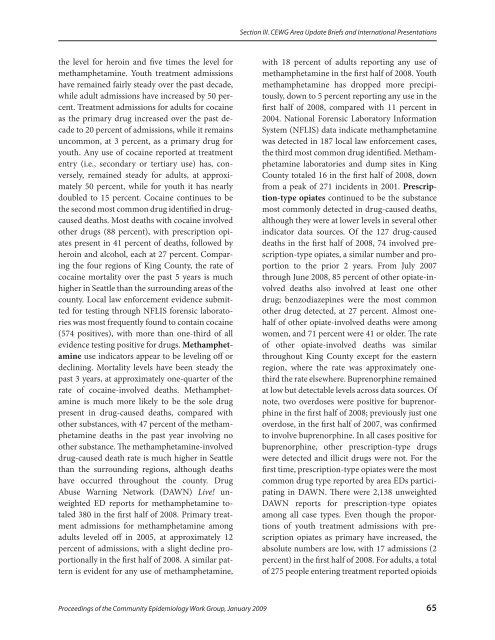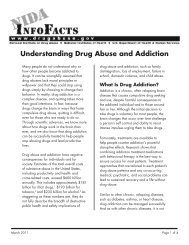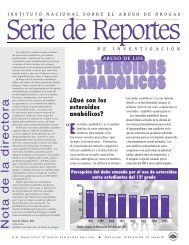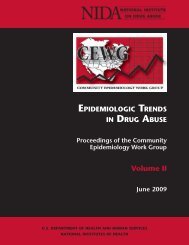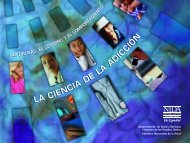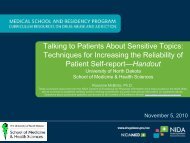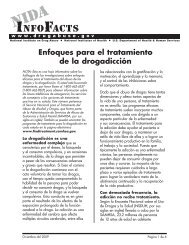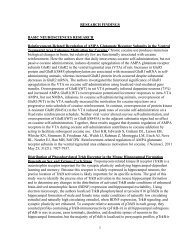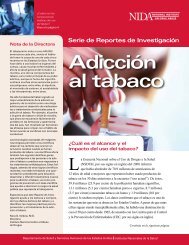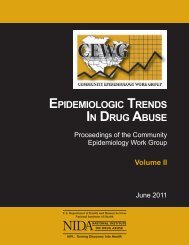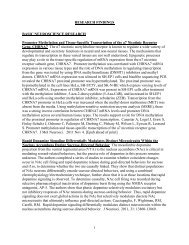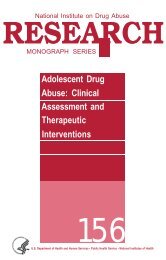CEWG January 09 Full Report - National Institute on Drug Abuse
CEWG January 09 Full Report - National Institute on Drug Abuse
CEWG January 09 Full Report - National Institute on Drug Abuse
Create successful ePaper yourself
Turn your PDF publications into a flip-book with our unique Google optimized e-Paper software.
Secti<strong>on</strong> III. <str<strong>on</strong>g>CEWG</str<strong>on</strong>g> Area Update Briefs and Internati<strong>on</strong>al Presentati<strong>on</strong>s<br />
the level for heroin and five times the level for<br />
methamphetamine. Youth treatment admissi<strong>on</strong>s<br />
have remained fairly steady over the past decade,<br />
while adult admissi<strong>on</strong>s have increased by 50 percent.<br />
Treatment admissi<strong>on</strong>s for adults for cocaine<br />
as the primary drug increased over the past decade<br />
to 20 percent of admissi<strong>on</strong>s, while it remains<br />
uncomm<strong>on</strong>, at 3 percent, as a primary drug for<br />
youth. Any use of cocaine reported at treatment<br />
entry (i.e., sec<strong>on</strong>dary or tertiary use) has, c<strong>on</strong>versely,<br />
remained steady for adults, at approximately<br />
50 percent, while for youth it has nearly<br />
doubled to 15 percent. Cocaine c<strong>on</strong>tinues to be<br />
the sec<strong>on</strong>d most comm<strong>on</strong> drug identified in drugcaused<br />
deaths. Most deaths with cocaine involved<br />
other drugs (88 percent), with prescripti<strong>on</strong> opiates<br />
present in 41 percent of deaths, followed by<br />
heroin and alcohol, each at 27 percent. Comparing<br />
the four regi<strong>on</strong>s of King County, the rate of<br />
cocaine mortality over the past 5 years is much<br />
higher in Seattle than the surrounding areas of the<br />
county. Local law enforcement evidence submitted<br />
for testing through NFLIS forensic laboratories<br />
was most frequently found to c<strong>on</strong>tain cocaine<br />
(574 positives), with more than <strong>on</strong>e-third of all<br />
evidence testing positive for drugs. Methamphetamine<br />
use indicators appear to be leveling off or<br />
declining. Mortality levels have been steady the<br />
past 3 years, at approximately <strong>on</strong>e-quarter of the<br />
rate of cocaine-involved deaths. Methamphetamine<br />
is much more likely to be the sole drug<br />
present in drug-caused deaths, compared with<br />
other substances, with 47 percent of the methamphetamine<br />
deaths in the past year involving no<br />
other substance. The methamphetamine-involved<br />
drug-caused death rate is much higher in Seattle<br />
than the surrounding regi<strong>on</strong>s, although deaths<br />
have occurred throughout the county. <strong>Drug</strong><br />
<strong>Abuse</strong> Warning Network (DAWN) Live! unweighted<br />
ED reports for methamphetamine totaled<br />
380 in the first half of 2008. Primary treatment<br />
admissi<strong>on</strong>s for methamphetamine am<strong>on</strong>g<br />
adults leveled off in 2005, at approximately 12<br />
percent of admissi<strong>on</strong>s, with a slight decline proporti<strong>on</strong>ally<br />
in the first half of 2008. A similar pattern<br />
is evident for any use of methamphetamine,<br />
with 18 percent of adults reporting any use of<br />
methamphetamine in the first half of 2008. Youth<br />
methamphetamine has dropped more precipitously,<br />
down to 5 percent reporting any use in the<br />
first half of 2008, compared with 11 percent in<br />
2004. <str<strong>on</strong>g>Nati<strong>on</strong>al</str<strong>on</strong>g> Forensic Laboratory Informati<strong>on</strong><br />
System (NFLIS) data indicate methamphetamine<br />
was detected in 187 local law enforcement cases,<br />
the third most comm<strong>on</strong> drug identified. Methamphetamine<br />
laboratories and dump sites in King<br />
County totaled 16 in the first half of 2008, down<br />
from a peak of 271 incidents in 2001. Prescripti<strong>on</strong>-type<br />
opiates c<strong>on</strong>tinued to be the substance<br />
most comm<strong>on</strong>ly detected in drug-caused deaths,<br />
although they were at lower levels in several other<br />
indicator data sources. Of the 127 drug-caused<br />
deaths in the first half of 2008, 74 involved prescripti<strong>on</strong>-type<br />
opiates, a similar number and proporti<strong>on</strong><br />
to the prior 2 years. From July 2007<br />
through June 2008, 85 percent of other opiate-involved<br />
deaths also involved at least <strong>on</strong>e other<br />
drug; benzodiazepines were the most comm<strong>on</strong><br />
other drug detected, at 27 percent. Almost <strong>on</strong>ehalf<br />
of other opiate-involved deaths were am<strong>on</strong>g<br />
women, and 71 percent were 41 or older. The rate<br />
of other opiate-involved deaths was similar<br />
throughout King County except for the eastern<br />
regi<strong>on</strong>, where the rate was approximately <strong>on</strong>ethird<br />
the rate elsewhere. Buprenorphine remained<br />
at low but detectable levels across data sources. Of<br />
note, two overdoses were positive for buprenorphine<br />
in the first half of 2008; previously just <strong>on</strong>e<br />
overdose, in the first half of 2007, was c<strong>on</strong>firmed<br />
to involve buprenorphine. In all cases positive for<br />
buprenorphine, other prescripti<strong>on</strong>-type drugs<br />
were detected and illicit drugs were not. For the<br />
first time, prescripti<strong>on</strong>-type opiates were the most<br />
comm<strong>on</strong> drug type reported by area EDs participating<br />
in DAWN. There were 2,138 unweighted<br />
DAWN reports for prescripti<strong>on</strong>-type opiates<br />
am<strong>on</strong>g all case types. Even though the proporti<strong>on</strong>s<br />
of youth treatment admissi<strong>on</strong>s with prescripti<strong>on</strong><br />
opiates as primary have increased, the<br />
absolute numbers are low, with 17 admissi<strong>on</strong>s (2<br />
percent) in the first half of 2008. For adults, a total<br />
of 275 people entering treatment reported opioids<br />
Proceedings of the Community Epidemiology Work Group, <str<strong>on</strong>g>January</str<strong>on</strong>g> 20<str<strong>on</strong>g>09</str<strong>on</strong>g> 65


